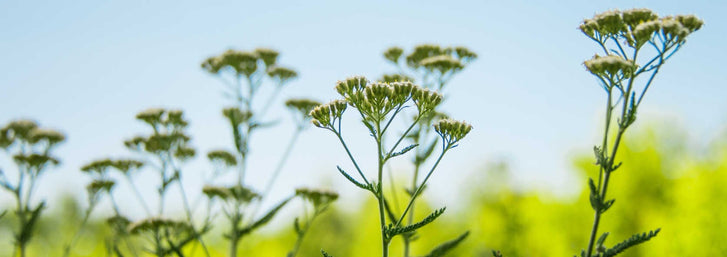
Ashleigh Smith

How to Protect Your Kitchen Garden From Soilborne Pathogens
Kitchen gardens are defined as an area where you grow different kind of vegetables and herbs for your daily use (oxford dictionary). Every year I grow different kinds of vegetables during the summer season especially cucurbits, solanaceous and leafy vegetables along with herbs like rosemary, basil, and mint. Being a gardener myself, dealing with soil borne pathogens has always been challenging for me. It causes both reductions in yield and quality of my vegetables. In the USA, soilborne plant pathogens are responsible for about 90% of the 2,000 major diseases of the principal crops including vegetables (Mokhtar and EL-Mougy, 2014).
Soilborne pathogens are living organisms, which live in the soil and cause disease. Soilborne pathogens include fungi, bacteria and nematodes (Koike et al., 2003). Some of the diseases caused by soilborne pathogens are root rot, pre and post-emergence damping off, foliar blight, vascular wilts and gall formations. Some of the pathogens causing those diseases are Phytophthora, Fusarium, Verticillium, Rhizoctonia, Sclerotium, Pythium species and Nematodes (Koike et al., 2003). Soilborne diseases are difficult to control because the pathogens often survive for long periods in host plant debris or in soil organic matter by producing resilient survival structures such as microsclerotia, sclerotia, chlamydospore or oospores (Panth et al., 2020). Pre-emergence damping-off causes seed rot before emergence from the soil surface whereas, post-emergence damping-off causes decaying of young seedlings after emergence (Koike et al., 2003; Donald, 2013). Rot symptoms can be observed either on underground or aboveground parts. Root rot usually affects the primary and secondary roots showing symptoms of discoloration of root and wilting due to interference in the supply of water and nutrients. Similarly, crown and stem rot show symptoms of yellowing and dropping of leaves, water-soaked lesions in stem, girdling of stem, wilting, and sudden death. Vascular wilts are characterized by wilting and discoloration of the vascular system at stems or trunks and branches (Koike et al., 2003). Nematodes can cause root galls, root lesions, stunted growth, yellowing and wilting of plants (Cornell University).
Management:
There are many methods to manage soil borne pathogen like cultural, chemical, and biological. Examples of these can include soil solarization, use of resistant cultivars, crop rotation with a non-host plant, removal of plant debris from last season to avoid the source of shelter for a pathogen to overwinter, proper irrigation (diseases like Phytophthora blight can spread from infested fields to healthy ones through water sources so don’t overwater your garden and there must be adequate drainage). More examples of management methods include, improving the soil fertility by applying the manure, compost, seed treatments with fungicides (which helps to manage seed and seedling diseases), use of chemicals like fungicides, use of beneficial microorganisms such as Trichoderma, Bacillus, Pseudomonas, Rhizobium, Serratia, and Streptomyces spp. (Chandler et al., 2011; Choudhary and Johri, 2009), use of biofumigants like Brassicaceae, Alliaceae plants. These methods have successfully managed many soilborne diseases to a certain extent (Panth et al., 2020).
The most commonly used method is chemical. It is easy, quick and effective but they are expensive as well as cause environmental pollution, food contamination, disturb the ecosystem by harming aquatic animals, pollinators and killing beneficial microorganisms. Along with that, the development of chemical resistance in the pathogen populations also makes chemical control less effective (Majid et al., 2017; Lamour and Hausbeck, 2000). So, there is always the need of a more sustainable, eco-friendly method. In kitchen garden, it’s always good to avoid use of chemicals because it directly impacts our health. Among all the mentioned methods, I personally use biofumigants by incorporating mustard, rapeseed, garlic, and onion in my vegetable list and I use beneficial microorganisms. They are effective, easy and an economic way to control soilborne diseases and improve soil health (Sarhan et al., 2020). Glucosinolate produced by Brassica crops, release isothiocyanates (ITC) upon hydrolysis which is responsible for managing soilborne diseases (Lewis and Papavizas, 1971). Similarly, Allium spp. contains thiosulfinates and disulfides, which shows the same activity as methyl bromide (Auger et al., 2004). If you want to use products available in the market, you can find different products like Rootshield, Actinovate, Terra-grow, Double nickel, and Serenade which are composed of many beneficial microorganisms and helps to manage soilborne disease. For nematode control, I would suggest using marigolds in infested fields. Marigold produces a substance known as α-therthienyl which is a natural nematicide which is responsible for controlling the population of nematodes once a nematode enters the marigold root (Wang et al., 2007).
So, I would suggest using biological or cultural methods in your garden rather than using chemicals in order to avoid environmental pollution and have healthy and safe food.

References:
- Auger, J.; Arnault, I.; Diwo-Allain, S.; Ravier, F.; Molia, M.; Pettiti, M. (2004). Insecticidal and fungicidal potential of Allium products and substances as biofumigants. Agroindustria, 3, 367–370.
- Chandler, D., Bailey, A. S., Tatchell, G. M., Davidson, G., Greaves, J., & Grant, W. P. (2011). The development, regulation and use of biopesticides for integrated pest management. Philosophical Transactions of the Royal Society B: Biological Sciences, 366(1573), 1987-1998.
- Choudhary, D. K., and Johri, B. N. (2009). Interactions of Bacillus spp. and plants–with special reference to induced systemic resistance (ISR). Microbiological research, 164, 493-513.
- Hershman E. Donald, 2013. Pre- and Post-Emergence Damping-Off of Soybean. University of Kentucky http://plantpathology.ca.uky.edu/files/ppfs-ag-s-05.pdf (Accessed on 26 April 2021).
- Koike, S., Subbarao, K., Davis, R. M., & Turini, T. (2003). Vegetable diseases caused by soilborne pathogens. UCANR Publications.
- Lewis, J. A., & Papavizas, G. C. (1971). Effect of sulfur-containing volatile compounds and vapors from cabbage decomposition on Aphanomyces euteiches. Phytopathology, 61, 208-214.
- Mokhtar, M. M., & El-Mougy, N. S. (2014). Bio-compost application for controlling soil-borne plant pathogens–a review. International Journal of Engineering and Innovative Technology, 4(1), 2277-3754.
- Oxford dictionary. Kitchen garden definition. https://www.oxfordlearnersdictionaries.com/us/definition/english/kitchen-garden#:~:text=%E2%80%8Ba%20part%20of%20a,from%20our%20own%20kitchen%20garden (Accessed on 26th April 2021).
- Panth, M., Hassler, S. C., & Baysal-Gurel, F. (2020). Methods for management of soilborne diseases in crop production. Agriculture, 10(1), 16.
- Plant Diagnosis Clinic. Nematodes: Plant Parasitic various. Cornell University, College of Agriculture and Life Sciences.http://plantclinic.cornell.edu/factsheets/nematodes.pdf (accessed on 26th April 2021).
- Sarhan, E. A., El-Sayed, S. A., Abdelmaksoud, H. M., & Elmarsafawy, T. S. (2020). Influence of Biofumigation with Mustard or Canola seed meal in controlling soil-borne pathogenic fungi of chickpea. Egyptian Journal of Agricultural Research, 98(1), 40-51.
- Wang, K. H., Hooks, C., & Ploeg, A. (2007). Protecting crops from nematode pests: using marigold as an alternative to chemical nematicides.
About the Author

I'm Ashleigh Smith, a native to Northern Utah. I first gained a love of gardening with my grandmother as I helped her each summer. I decided to make a career of it and have recently graduated with a Bachelor's degree in Horticulture from Brigham Young University - Idaho. My studies have focused on plant production while I also have experience in Nursery & Garden Center Operations.
Become a True Leaf Market Brand Ambassador! You’ll enjoy awesome perks, free products and exclusive swag & offers! Help us create a gardening revolution and help others experience the joy of growing!
Leave a comment
Your email address will not be published. Required fields are marked *
1 comments
Damon Mabry
Great and informative essay. Congratulations on your scholarship and wishing you nothing but the best for your future!
Further Reading

10 Natives of the Southwest USA for Pest Control
Written By Lara Wadsworth The Southwestern United States is a region incredibly unique to the rest of the country. The hot, dry weather can be challenging for plants and animals to thrive without additional help. That is why gardening with natives can ...

Ashleigh Smith
2024-04-157 min read0
Spring Into Action - Celebrating Earth Day
Written By Chelsea Hafer Spring is quickly arriving, and that means that Earth Day is near! Earth Day is the perfect occasion to appreciate our wonderful planet and all that it does for us and think of ways you can give back to it. In this blog post, w...

Ashleigh Smith
2024-04-154 min read0
Everything You Need To Know About Rain Gardens
Written By Lara Wadsworth Rain gardens are quickly gaining popularity for their perfect marriage of utility and beauty. What simply looks like a beautifully landscaped garden is actually a native habitat that serves as a storm drain and water sponge. B...

Ashleigh Smith
2024-04-085 min read1
Northeastern Natives for Attracting Beneficial Insects
Written By Lara Wadsworth The Northeastern United States is rich with American history, but did you also know that it is rich in plant biodiversity? Nature has learned through time how to work in harmony with the various species that attempt to thrive....

Ashleigh Smith
2024-04-086 min read1



